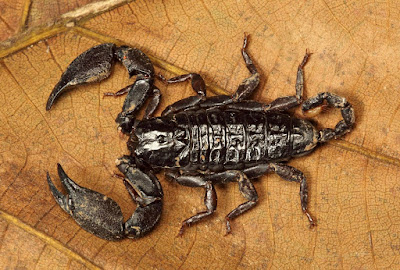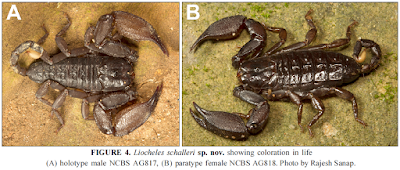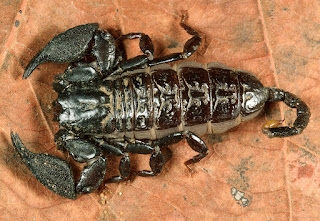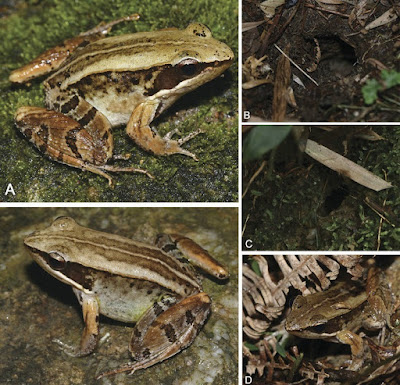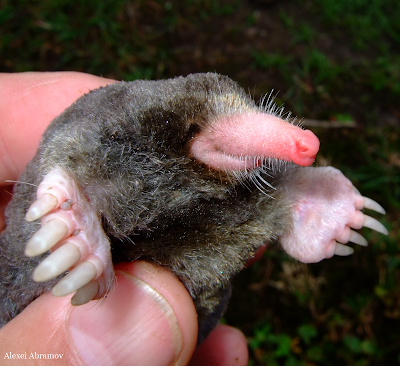[Most Recent Entries] [Calendar View]
Wednesday, December 20th, 2017
| Time | Event | ||||||
| 2:00a | [Arachnida • 2017] Liocheles schalleri • A New Species of Liocheles Sundevall, 1833 (Hormuridae) from northeast India
Abstract Scorpions of the genus Liocheles Sundevall, 1833 are widespread in forests of the Indo-Pacific region; however, its species diversity is poorly resolved. A new species of the genus Liocheles is herein described from northeast India after examination of freshly collected specimens and available museum material. The new species, Liocheles schalleri sp. nov., occurs in the Indo-Burma biodiversity hotspot, a region that has been poorly explored for its arachnid diversity.
Liocheles schalleri sp. nov. Etymology: The specific epithet is a patronym honoring Wildlife Biologist Dr. George Beals Schaller of the Wildlife Conservation Society and Panthera, for his contribution to conservation of wildlife.
Zeeshan A. Mirza. 2017. Description of A New Species of Liocheles Sundevall, 1833 (Hormuridae) from India. Zootaxa. 4365(2); 217–230. DOI: 10.11646/zootaxa.4365.2.6 4 specimens of species were collected from Trishna Wildlife Sanctuary in Tripura - Bangalore Mirror bangaloremirror.indiatimes.com/news/stat | ||||||
| 10:20a | [Herpetology • 2017] Nidirana nankunensis • Resurrection of Genus Nidirana (Anura: Ranidae) with Description of A New Species from China
The taxonomy of Babina sensu lato was controversial in the past decades. In this study, the phylogeny of genus Babina sensu lato was re-constructed based on genetic analysis, morphological comparison and advertisement call analysis. We found that Babina sensu stricto and previous subgenus Nidirana should be two distinct genera in the family Ranidae. N. caldwelli is confirmed to be a synonym of N. adenopleura because of the small genetic divergence and the lack of distinct morphological differences. A new species, Nidirana nankunensis sp. nov. is described based on a series of specimens collected from Mt. Nankun, Guangdong Province, China, which can be distinguished from other known congeners by having a behavior of nest construction, distinctive advertisement calls, significant divergence in the mitochondrial genes, and a combination of morphological characters. Currently, the genus Babina contains two species and the genus Nidirana contains eight species. Keywords: Babina, bioacoustic, mitochondrial DNA, morphology, Nidirana nankunensis sp. nov., phylogeny.
Nidirana nankunensis sp. nov. Etymology. The specific name “nankunensis”refers to the type locality of the new species, the Mt. Nankun. We suggest its English common name “Mt. Nankun Music Frog” and Chinese name “Nan Kun Shan Qin Wa”. Zhi-Tong Lyu, Zhao-Chi Zeng, Jian Wang, Chao-Yu Lin, Zu-Yao Liu and Ying-Yong Wang. 2017. Resurrection of Genus Nidirana (Anura: Ranidae) and synonymizing N. caldwelli with N. adenopleura, with Description of A New Species from China. Amphibia-Reptilia. DOI: 10.1163/15685381-00003130 | ||||||
| 10:29a | [Mammalogy • 2016] Euroscaptor orlovi & E. kuznetsovi • Secrets of the Underground Vietnam: An Underestimated Species Diversity of Asian Moles (Lipotyphla: Talpidae: Euroscaptor)
ABSTRACT A study of the Southeast Asian moles of the genus Euroscaptor based on a combined approach, viz. DNA sequence data combined with a multivariate analysis of cranial characters, has revealed a high cryptic diversity of the group. An analysis of mitochondrial cytochrome b gene and five nuclear genes has revealed two deeply divergent clades: the western one (E. klossi + E. malayana + E. longirostris from Sichuan + Euroscaptor spp. from northern Vietnam and Yunnan, China), and the eastern one (E. parvidens s.l. + E. subanura). The pattern of genetic variation in the genus Euroscaptor discovered in the present study provides support for the existence of several cryptic lineages that could be treated as distinct species based on their genetic and morphological distinctness and geographical distribution. The moles from southern China and northern Vietnam form three distinct groups. The specimens from Sichuan (including the one collected from the type locality of E. longirostris) were clearly distinct from the northwestern Vietnam and Yunnan samples that were previously attributed to this species. We argue that the real distribution of E. longirostris is restricted to Sichuan, northward of Yangtze River, whereas the populations occurring southward of this isolation barrier evidently represent a new species Euroscaptor orlovi sp. nov. (northwestern Vietnam and Yunnan, southern China). Moreover, Red River that divides the western and eastern parts of northern Vietnam beyond doubt separates the population of E. orlovi from the moles occurring in northeastern Vietnam (Vinh Phuc and Cao Bang provinces); the latter are described here as Euroscaptor kuznetsovi sp. nov. Yet, genetic data are in favour of a close affinity of E. subanura with E. parvidens. A combined analysis of both genetic and morphological data has revealed a strong geographic segregation of E. parvidens samples. The populations from Dalat Plateau (southern Vietnam), including the moles from Loc Bao, Bi Dup and Chu Yang Sin, form a well-supported clade and can be considered true E. parvidens. The specimens from central Vietnam (Kon Tum and Quang Nam provinces) are significantly different from them, yet their monophyly has been supported by the mtDNA only. The moles from central Vietnam have been described here as a new subspecies Euroscaptor parvidens ngoclinhensis ssp. nov. All the studied samples of E. subanura have shown a low genetic and morphological variability despite their wide geographic range. Key words: cryptic species, Euroscaptor, multilocus phylogeny, multivariate analyses, taxonomy SYSTEMATICS Genus Euroscaptor Miller, 1940 Type species: Talpa klossi Thomas, 1929. Distribution: widely distributed in South Asia, occurring in China, Nepal, Laos, Vietnam, Myanmar, Thailand, and Peninsular Malaysia. Composition: Euroscaptor klossi (Thomas, 1929), Euroscaptor longirostris (Milne-Edwards, 1870), Euroscaptor malayana (Chasen, 1940), Euroscaptor parvidens (Miller, 1940), Euroscaptor subanura Kawada et al., 2012, Euroscaptor orlovi sp. nov., and Euroscaptor kuznetsovi sp. nov. (see descriptions below). Probably, also includes Euroscaptor grandis Miller, 1940 and Euroscaptor micrura (Hodgson, 1841). The taxonomic status of “Talpa” cryptura Blyth, 1843 from Darjeeling, India remains obscure. Euroscaptor orlovi sp. nov. Diagnosis. Large-sized mole, comparable to E. longirostris. Pelage blackish brown. Tail long and club-shaped. Rostral part of skull elongated and narrow. Posterolingual border of P4 deeply concave. Anterior parts of auditory bullae flatted and straddling. A new species distinguished by the mitochondrial gene cytochrome b and five nuclear genes (BRCA1, BRCA2, ApoB, RAG1 and A2ab) (see Figs 2–4). Etymology. The new species is named in honour of Dr. Nikolai L. Orlov (Zoological Institute, Russian Academy of Sciences, Saint Petersburg, Russia) in recognition of his remarkable contributions to the study of animals of Vietnam. Distribution. Found in northern Vietnam (Lao Cai Province, Sa Pa District) and southern China (Yunnan Province). It may have a wider distribution in the highlands of northern Laos and in northwestern Vietnam, probably westward of Red River. Euroscaptor kuznetsovi sp. nov. Diagnosis. Large-sized mole, comparable to E. longirostris and E. orlovi sp. nov. Pelage blackish brown. Tail long and club-shaped. Rostral part of skull elongated and relatively wide. Posterolingual border of P4 deeply concave. Anterior parts of auditory bullae flatted and straddling. A new species distinguished by the mitochondrial gene cytochrome b and five nuclear genes (BRCA1, BRCA2, ApoB, RAG1 and A2ab) (see Figs 2–4). Etymology. The new species is named in honour of Dr. German V. Kuznetsov (A.N. Severtsov Institute of Ecology and Evolution, Russian Academy of Sciences, Moscow) in recognition of his many contributions to the study of mammals of Vietnam. Distribution. Distributed in north-eastern Vietnam. It is recorded from Vinh Phuc Province (Tam Dao) and Cao Bang Province (Nguyen Binh District). Found at the elevations of 750–950 m a.s.l. Probably, the record from Guangxi, south-eastern China (Hoffman and Lunde 2008) belongs to this species as well. Euroscaptor parvidens ngoclinhensis subsp. nov. Diagnosis. Small-sized mole, comparable only to E. subanura, and smaller on average in its external and cranial measurements than the nominotypical E. parvidens. The fourth upper premolar with a well developed parastyle. A new species distinguished by the mitochondrial gene cytochrome b (see Fig. 2). Etymology. The subspecies is named after the Ngoc Linh Mountain in Kon Tum Province of Vietnam, from where it was collected for the first time. Distribution. Known from the Central Highlands of Vietnam (Kon Tum and Quang Nam provinces). Probably, the moles from Gia Lai Province (Abramov et al. 2013a) belong to this subspecies. E.D. Zemlemerova, A.A. Bannikova, V.S. Lebedev, V.V. Rozhnov and A.V. Abramov. 2016. Secrets of the Underground Vietnam: An Underestimated Species Diversity of Asian Moles (Lipotyphla: Talpidae: Euroscaptor) [ТАЙНЫ ПОДЗЕМНОГО ВЬЕТНАМА: НЕДООЦЕНЕННОЕ ВИДОВОЕ РАЗНООБРАЗИЕ АЗИАТСКИХ КРОТОВ (LIPOTYPHLA: TALPIDAE: EUROSCAPTOR)]. Proceedings of the Zoological Institute RAS. 320(2); 193–220. istina.msu.ru/publications/article/22015 Stranger Species shar.es/1M90OQ |
| << Previous Day |
2017/12/20 [Calendar] |
Next Day >> |

